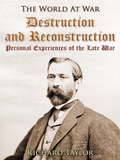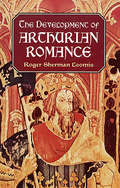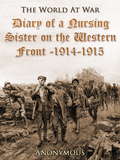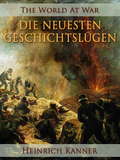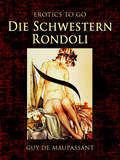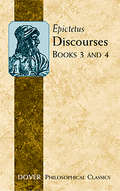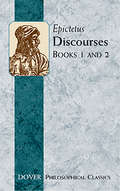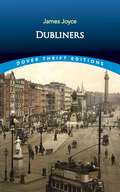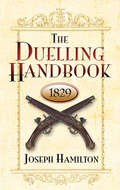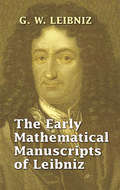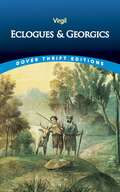- Table View
- List View
Destruction and Reconstruction: Personal Experiences Of The Late War (The World At War)
by Richard TaylorIn this unique series, the Civil War comes vividly to life, as those who were there give eye-witness accounts from both sides of the bloody conflict. A sugar farmer and gentleman politician with no military training before the war, General Richard Taylor--son of President Zachary Taylor--plays a major role in the Red River campaign. Out of print since 1879. (Excerpt from Goodreads)
The Development of Arthurian Romance
by Roger Sherman LoomisStimulating and masterly study examines the evolution of the great mass of fiction surrounding the Arthurian legend in Western literature -- from Geoffrey of Monmouth's History of the Kings of Britain and the collection of Welsh tales known as The Mabinogion, to Chrétien de Troyes' Arthurian stories, the Parzival of Wolfram von Eschenbach, and such English masterpieces as Sir Gawain and the Green Knight and Le Morte d'Arthur. Painstakingly researched and brimming with scholarly insight, this highly readable and entertaining work will be a favorite with general audiences as well as scholars and students of the Arthurian legend.
Diary of a Nursing Sister on the Western Front, 1914-1915: 1914-1915 (The World At War)
by Anonymous AnonymousExcerpt from book: “Friday, December 18th, 10.30 A.M.--We've had an all-night journey to Rouen, and have almost got there. One of my sitting-ups was 106° this morning, but it was only malaria, first typical one I have met since S.A. A man who saw the King when he was here said, "They wouldn't let him come near the trenches; if a shell had come and hit him I think the Army would 'a gone mad; there'd be no keeping 'em in the trenches after that."
The Diary of an Ambassador Vol. I: Versailles to Rapallo 1920-1922 (The Diary of an Ambassador #1)
by Edgar D’AbernonOriginally published in 1929, in this first volume in a series of three, The Right Honourable Viscount D’Abernon aims to illustrate “the early phases through which negotiations passed between the Great Powers and Germany in the years before the Treaty of Locarno was signed and before Germany entered the League of Nations. The pages are principally concerned with the subjects of reparation, German disarmament, and with the German financial crisis. Professor Gerothwohl has undertaken the task of annotating the Diary, and of supplying the links necessary to a comprehension of the historical sequence of events. A more competent guide could not be desired, his grasp of the European situation at the period being probably unrivalled. It has been thought expedient to limit explanation to the bare minimum required for clarity, and to allow the Diary to speak as far as possible for itself.“How far the reader will find that the present volume fulfils its purpose and furnishes the necessary knowledge for a comprehension of the period is not for me to say, but it may be hoped that a clear idea will be gained of the essential object before English statesmanship, namely, the restoration of peace to Europe.”—1st Viscount D’Abernon, Introductory SurveyA fascinating read and invaluable addition to the British Historian’s book collection.
The Diary of an Ambassador Vol. II: Rapallo to Dawes 1922-1924 (The Diary of an Ambassador #2)
by Edgar D’AbernonOriginally published in 1930, this second volume in a series of three portrays the history of 1922 and 1923. In this volume, 1st Viscount D’Abernon centres on the occupation of the Ruhr by French troops; the events immediately preceding that occupation and leading up to it; the consequences of that occupation; and the results, “good and bad,” which proceeded from it—”notably the dramatic collapse of German finance.”“The essential fact to be borne in mind in the study of 1923 is that this year witnessed the culminating point of the conflict between the policy of force and the policy of pacification.“The first volume of these memoirs was concerned mainly with debate and discussion. In Volume II deeds replace words, drastic action is not merely threatened but ruthlessly enforced. The menace of overpowering catastrophe darkens the horizon and imparts tragic significance to events. It was a time of decisive importance in the history of Europe: the years of war were hardly more charged with fate. In 1923 the condition was indeed one of virtual warfare. On the side of France, a resolute will, a clear policy, and overpowering military strength. On the side of Germany, a courage born of despair, a certain sense of injustice, and a hope that the world would not endorse action which many deemed spoliation.”—1st Viscount D’Abernon, Introductory SurveyA fascinating read and invaluable addition to the British Historian’s book collection.
The Diary of an Ambassador Vol. III: Dawes to Locarno 1924-1926 (The Diary of an Ambassador #3)
by Edgar D’AbernonOriginally published in 1931, this third volume in a series of three portrays the history of 1924 to 1926. In this final volume, 1st Viscount D’Abernon examines three major events: the Dawes settlement in 1924, the Locarno Agreement in 1925, and the entry of Germany into the League of Nations in 1926. Of these three events, D’Abernon holds that the greatest was Locarno.“Dawes laid the foundation—Geneva crowned the edifice, but the essential building was carried through in October 1925, in that now historic village on the Italian lakes. Imagination has been stirred by Locarno—Locarno is the central theme of the present volume.”—1st Viscount D’Abernon, General SurveyA fascinating read and invaluable addition to the British Historian’s book collection.
Die neuesten Geschichtslügen (The World At War)
by Heinrich KannerHeinrich Kanner (* 9. November 1864 in Galați; † 15. Februar 1930 in Wien) war ein österreichischer Politiker, Journalist und Zeitungsherausgeber. Noch während des Weltkrieges begann Heinrich Kanner seine Recherche nach der Kriegsschuldfrage. Zu diesem Zwecke interviewte er während des Krieges eine Reihe von prominenten Vertretern des öffentlichen Lebens darunter auch mehrfach Leon von Bilinski, der von 1912 bis 1915 gemeinsamer Finanzminister der Donaumonarchie war und an den entscheidenden Sitzungen und Besprechungen über die Außenpolitik in dieser Zeit teilgenommen hat. Bilinski bezeugte in den Gesprächen mit Kanner, dass Kaiser Franz Joseph seit dem Frühjahr 1913 fest entschlossen war, nötigenfalls eine Aktion am Balkan zu genehmigen und zwar unbeschadet des Risikos eines Zusammenstoßes mit Russland. (Auszug aus Wikipedia)
Die Schwestern Rondoli: Revised Edition Of Original Version (Erotics To Go)
by Guy MaupassantZwei Männer und ein recht seltsames Mädchen. Aus Maupassants erotischen Erzählungen.
Discourses: Books 3 and 4
by Epictetus P. E. MathesonIn this compilation of Books 3 and 4 of Epictetus' Discourses -- the second of a two-volume set -- the philosopher discusses the quest for freedom, the nature of solitude, cynicism, fear, discretion, the avoidance of quarrels, and other subjects of enduring interest and concern.
Discourses: Books 1 and 2
by Epictetus P. E. MathesonThe ne plus ultra of Stoicism, Discourses outline clear-cut principles of right conduct and true thinking, offering secular thinkers a mode of reasoning that dismisses the strictures of absolutism and emotionalism in exchange for a more peaceful and productive life. The Discourses report wide-ranging discussions between Epictetus and his students.
Domestic Manners of the Americans
by Frances TrollopeFrances Trollope, mother of the great Victorian novelist Anthony Trollope, wrote more than 40 books in her lifetime, including provocative, landmark novels dealing with important social issues. Today, however, she's best known for her witty, entertaining, and controversial account of American life and culture — Domestic Manners of the Americans. First published in 1832, this travel classic presents a lively portrait of early nineteenth-century America as observed by a woman of rare intelligence and keen perception.Mrs. Trollope left no stone unturned, commenting on American dress, food, speech, politics, manners, customs, the landscape, architecture, and more — often critically, occasionally admiringly, but always with considerable insight and fine literary flair. Of her, Mark Twain observed: "Of all the tourists I like Dam Trollope best, she found a 'civilization' here which you, reader, could not have endured; and which you would not have regarded as civilization at all. Mrs. Trollope spoke of this civilization in plain terms — plain and unsugared, but honest and without malice, and without hate. "An immediate bestseller on its first publication, the book remains one of the most popular of all American travel accounts.
Don Quixote: In English Translation, With Active Table of Contents (Dover Thrift Editions)
by Miguel De Cervantes Tobias SmollettHailed by Dostoyevsky as "The final and greatest utterance of the human mind," Don Quixote constitutes a founding work of modern Western literature. Cervantes' masterpiece has been translated into more than sixty languages, and the novel's fantasy-driven "knight," Don Quixote, and his loyal squire, Sancho Panza, rank among fiction's most recognized characters. Their adventures have been interpreted for film, opera, and ballet, and they head a cast of characters that comprises a diverse array of beliefs and perspectives, reflecting the historical realities of seventeenth-century Spain. Within its absorbing re-creation of the world during Cervantes' time, this parody of chivalric romances and epic of heroic idealism forms a strikingly contemporary narrative. The author is often credited with inventing the concept of the novel, addressing himself to the readers rather than the characters or the action. This edition of his landmark work presents the acclaimed 1755 Tobias Smollett translation.
Donald McKay and His Famous Sailing Ships (Dover Maritime Series)
by Richard C. McKay"A magical tale of a master-mechanic and creative artist, whose genius lifted the construction of sailing ships from the level of a journeyman's trade to the plane of an exact science. He stands pre-eminent among those acute and daring Americans whose marine achievements were the wonder of the world … and enthroned the United States of America as Mistress of the Seas!" — Foreword.Donald McKay was the presiding genius of the nineteenth-century designer-builders who brought the American clipper ship and other sailing vessels to the acme of perfection. Year after year, his shipyard in East Boston launched a flotilla of the largest, fastest, and most beautiful clippers afloat. Such vessels as the famed Flying Cloud, Sovereign of the Seas, Flying Fish, Westward Ho, Great Republic, and many more surpassed in size, beauty, strength, and speed all that had gone before. McKay's ships proclaimed a new era of American supremacy on the high seas and helped put her first among the trading nations of the world.This rare and valuable study, written by McKay's descendant who had access to important family records, reveals McKay's extraordinary accomplishments as it re-creates the great era of the American sailing packet and clipper ship. In the end, steamships replaced McKay's masterworks, but never eclipsed the magnificent sailing tradition whose climax they represented.Enhanced with 58 superb illustrations, including numerous views of McKay's ships — in port, on the high seas, and in close-up detail — along with a wealth of plans, models, maps, and other materials, this volume will find an eager audience among ship enthusiasts and modelers, marine historians, and lovers of Americana.
Dubliners
by James JoyceAlthough James Joyce began these stories of Dublin life in 1904, when he was 22, and had completed them by the end of 1907, they remained unpublished until 1914 — victims of Edwardian squeamishness. Their vivid, tightly focused observations of the life of Dublin's poorer classes, their unconventional themes, coarse language, and mention of actual people and places made publishers of the day reluctant to undertake sponsorship.Today, however, the stories are admired for their intense and masterly dissection of "dear dirty Dublin," and for the economy and grace with which Joyce invested this youthful fiction. From "The Sisters," the first story, illuminating a young boy's initial encounter with death, through the final piece, "The Dead," considered a masterpiece of the form, these tales represent, as Joyce himself explained, a chapter in the moral history of Ireland that would give the Irish "one good look at themselves." But in the end the stories are not just about the Irish; they represent moments of revelation common to all people.Now readers can enjoy all 15 stories in this inexpensive collection, which also functions as an excellent, accessible introduction to the work of one of the 20th century's most influential writers. Dubliners is reprinted here, complete and unabridged, from a standard edition.
The Duelling Handbook, 1829
by Joseph HamiltonProfoundly embedded in our cultural consciousness, the art of duelling evokes images of a dramatic past, where the laws of courtesy, civility, and honor were enforced by the end of a rapier at the first rays of dawn. In this engrossing historical record of the codes and conduct of the duel — originally written in 1829 as "The Only Approved Guide Through All the Stages of a Quarrel" — every aspect of the arcane practice is brought to fascinating light.Offering authentic advice on such subjects as withdrawal of challenges, weapons, distance, and the fate of survivors, The Duelling Handbook also brims with vivid anecdotes recounting duels between brothers, duels between friends, and those arising from disagreements over religion, women, gambling, and other volatile standpoints. A genuine historical treasure, Hamilton's unequaled guidebook will captivate — and enlighten — a wide audience of readers, especially those intrigued by the moral and sociological issues surrounding the art of the duel.
Early American Houses: With A Glossary of Colonial Architectural Terms
by Norman Morrison IshamAn intriguing examination of classic colonial houses, this fact-filled foray explores with remarkable concision the "medieval period" of American architecture. The treatise takes for its examples the first houses built along the Atlantic coast in the seventeenth century. While these early structures were usually based on traditional English and Dutch styles, their design and methods of construction soon acquired a unique character of their own. Geographically remote from the stylistic restrictions of Europe, American architects used new plans and construction elements to create fresh new dwellings with individual beauty and charm. Early American Houses includes over 100 photographs and illustrations that highlight the architecture of young America, with a particular focus on the Tudor and late Gothic styles that ultimately shaped the distinctive house designs of today. Original floor plans and sketches abound -- including interior and exterior treatments, elevations, and framing -- partnered with detailed descriptions that breathe life into each construction. Accompanying this work is a comprehensive Glossary of Colonial Architectural Terms. Originally published separately, it provides definitions for everything from "arch" to "wainscot," and it is reprinted here to enhance the overall value of the companion volume.
Early American Steam Locomotives
by Reed KinertRelive the early days of train travel with this exciting illustrated story of steam locomotion. Working with great love and skill from builders' specifications, old engravings, and contemporaneous accounts, author Reed Kinert recreates, in exacting detail, illustrations of the earliest locomotives—many of which were built and used before the advent of photography.More than 100 illustrations, many in color, portray the venerable "iron horses"—from the tiny Tom Thumb (which, early in its career, lost a race to a horse-drawn wagon) to vertical "teakettles" and "grasshoppers," and the streamlined "titans," outfitted with bells, whistles, and lights. Railroading enthusiasts, model rail hobbyists, and Americana buffs will be delighted with this expert pictorial-guided tour through the early days of the "iron horse."
Early Economic Thought: Selected Writings from Aristotle to Hume
by Arthur Eli MonroeA vital and varied survey of economic theory in the pre-modern era, this well-chosen collection includes extracts from the works of Aristotle, Thomas Aquinas, Antonio Serra, David Hume, and twelve other extraordinary thinkers. Their writings in this volume illustrate the ways in which great thinkers of the past sought to argue for and explain the moral, ethical, monetary, and political dimensions of trade and exchange.Translated and annotated by noted Harvard educator Arthur Eli Monroe, these writings offer invaluable background to students of modern economic theory. Sufficiently varied to reflect the wealth of available material, they include highlights from Aristotle's Politics and Nicomachean Ethics, St. Thomas Aquinas's Summa Theologica, Thomas Mun's England's Treasure by Forraign Trade, and David Hume's Political Discourses. Helpful biographical notes appear at the start of each author's work.
The Early Mathematical Manuscripts of Leibniz
by G. W. Leibniz J. M. ChildThe manuscripts and correspondence of Leibniz possess a special interest: they are invaluable as aids to the study of their author's part in the invention and development of the infinitesimal calculus. In addition, the main ideas behind Leibniz's philosophical theories lay here, in his mathematical work.This volume consists of two sections. The first part features Leibniz's own accounts of his work, and the second section comprises critical and historical notes and essays. An informative Introduction leads to the "postscript" to Leibniz's 1703 letter to James Bernoulli, his "Historia et Origio Calculi Differentialis," and manuscripts of the period 1673-77. Essays by the distinguished scholar C. I. Gerhardt follow--Leibniz in London and Leibniz and Pascal, along with additional letters and manuscripts by Leibniz.
The Ecclesiastical History of the English People
by The Venerable Bede A. M. SellarThis masterpiece of medieval historical literature constitutes the first account of English history. Written in 731 AD by a Northumbrian monk, it chronicles the growth of Christianity in Anglo-Saxon England. The Venerable Bede's account starts with the Roman invasion led by Julius Caesar in 55-54 BC and extends to the date of its completion. It profiles the kings, bishops, monks, and nuns involved in the formation of the island nation's religion and government.Known today as The Father of English History, Bede was among the most learned man of his time. His History illuminates a period otherwise obscured by the absence of written evidence and illustrates the Church's use of persuasion to overcome pagan violence. Essential reading for students of history and theology, it ranks among the most important primary sources of Western history.
Eclogues and Georgics
by VirgilWith the Eclogues, Virgil established his reputation as a major poet, and with the Georgics, he created a masterpiece of Latin poetry. Virgil drew upon the tradition of Greek pastoral poetry, importing it into an Italian setting and providing in these two works the model for subsequent European interpretations of the genre.The Eclogues unfolds in an idyllic landscape, under less-than-tranquil circumstances. Its shepherds tend their flocks amid not only the inner turmoil of unrequited love but also the external pressures of the civil war that followed Julius Caesar's assassination in 44 B.C. Forced from their homes, the dispossessed shepherds voice a heartfelt longing for peace.Dryden declared the Georgics "the best poem by the best poet," and through the ages, it has been much admired and imitated. A paean to Italy and the country's natural beauty, it rejoices in the values of rustic piety, the pleasures of family life, and the vitality of the Italian people.
An Economic Interpretation of the Constitution of the United States (Barnes and Noble Digital Library)
by Charles A. BeardIn this famous study, the author turned the hagiography of many earlier American historians on its head. Unlike those writers, who had stressed idealistic impulses as factors determining the structure of the American government, Beard questioned the Founding Fathers' motivations in drafting the Constitution and viewed the results as a product of economic self-interest.Brimming with human interest, insights, and information every student of American history will prize, this volume — one of the most controversial books of its time — continues to prompt new perceptions of the supreme law of the land."A staple for history and economics collections." — Library Journal."Replete with human interest and compact with information of importance to every student of American history or of political science." — Annals of the American Academy of Political and Social Science.
Economic Origins of Jeffersonian Democracy: How Hamilton's Merchant Class Lost Out to the Agrarian South
by Charles A. Beard Prof. Clyde W. BarrowThe sequel to the bestselling An Economic Interpretation of the Constitution, this volume focuses on the nation's early political history from the adoption of the Constitution through the end of the Jefferson administration. This period saw the rise and triumph of Jefferson's agrarian, slave-holding South over the mercantile-oriented urbanism of Hamilton's North, setting the stage for the ongoing clash between rural and urban America, a topic still highly relevant in the twenty-first century. Beard defines the early period of American governance in terms of the conflict between agrarianism and fluid capital that dominated the campaign for the ratification of the Constitution. He traces this dispute across three decades into its manifestations as Federalism versus Republicanism and later into Federalism and Jeffersonian Democracy. Broad in scope, Beard's view places the struggles within the context of social and cultural developments, and his interpretation provides an excellent resource for students of the historical background of American politics.
Egyptian Decorative Art
by W. M. PetrieClassic examination of the historical development of Egyptian decorative art, including the writing of hieroglyphs and the origin of patterns. Over 200 carefully drawn figures illustrate spirals, feathers, rosettes, lotus blossoms, basket work, cornices, gods and goddeses, scarabs, and more. Invaluable to students of fine art, art history, and the decorative arts.
Egyptian Hieroglyphic Grammar: A Handbook for Beginners
by Gunther RoederWritten and spoken for about 4,000 years, Egyptian is no longer a living language (Arabic is the major language of modern Egypt); however, ancient Egyptian is still studied by Egyptologists, historians, archaeologists, and students interested in the age-old civilization along the Nile.Typically, students of ancient Egyptian begin with Middle, or Classical, Egyptian, which was written in hieroglyphic script. Middle Egyptian is especially important because it is the language in which many important literary works were written. Moreover, when it was no longer spoken, Middle Egyptian continued to be taught in temples and schools as a vehicle of literary and liturgical expression.This compact handbook, by a noted German Egyptologist, was specially designed for beginning students who wish to acquire enough basic knowledge to enable them to read the easier hieroglyphic texts. Toward that end, the author begins with a general discussion of Middle Egyptian and its script, followed by concise, accessible lessons in phonology, formation and usage of nouns and other parts of speech, and syntax. With careful study, the student should be able, even after the first lesson, to translate simple sentences independently. A list of hieroglyphs, a vocabulary section, and reading exercises complete this handy manual that offers students quick and easy access to the language and culture of ancient Egypt.
